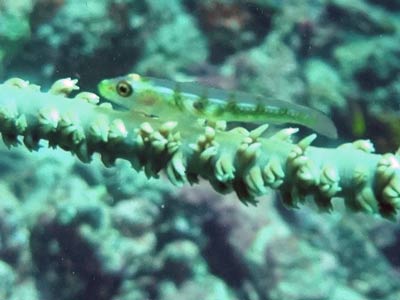|
Michael McFadyen's Scuba Diving - Lush Spot, Queensland
Great Detached Reef is located at the northern end of the Great Barrier Reef off Queensland, Australia. It is about 125 nautical miles (230 kilometres) from Thursday Island in the Cape York area (the pointy tip of Australia) and 75 nm (140 kilometres) from Lockhart River. The is 45 nm (85 kilometres) east-north-east from closest point of the Australian mainland, Cape Grenville. It is just over 4 nm south of Raine Island, the largest green turtle nursery in the world.
 |  |
A chart showing the location of Great Detached Reef (bottom right)
and Thursday Island (top left) | Great Detached Reef - Lush Spot
is located on the south-western side of Wood Reef as marked |
Great Detached Reef is a reversed C shaped reef made up of a number of separate sections. It is located a little off what is the main outside section of the Great Barrier Reef, although here that reef is merely a series of small bommies or reefs. Great Detached Reef is 11.5 nm from north to south and 8.8 nm east to west. The west (open) side of the reef has a series of bommies and small reefs along a large part of its length.
There are only a couple of boats that travel to this area, one being Kalinda which routinely does full boat charters there in November and December. Another boat does some trips there and one more might go there once or twice a year.
Kelly and I travelled here in November 2016 on Kalinda with fellow members of St George Scuba Club when we chartered the whole boat. We flew into Horn Island (next to Thursday) and started our trip from there.
Lush Spot is located on the south-western side of Wood Reef which is about 0.7 nautical miles south-west of the south-western corner of Great Detached Reef. Wood Reef is a triangular shaped reef about 2.5 by 1.5 nautical miles. The longest length runs north-west to south-east. Woodies' location is GPS S11Âș 48' 36.1" E143Âș 57' 50.8".
 |  |
| Kelly on the shear wall | Kelly with a few large gorgonias |
We anchored in a sandy gutter that runs from 8 to 25 metres. The reef wall here drops from five metres to over 70 metres. We start the dive by dropping down the anchor and then heading south-east along the wall.
As mentioned, the wall drops dramatically, it is almost vertical in sports. As we swim along at about 30 metres, we see lots of gorgonias as well as a few sea whips and sea fans. Many of the gorgonias are huge, two or more metres across. The gorgonias and sea whips sometimes have small inhabitants. The sea whips nearly always have clingfish and a type of shrimp. The gorgonias have shrimp and sometimes spindle cowries.
 |  |
| Another huge gorgonia | A clingfish on a sea whip |
We gradually come up as we go, staying out of decompression. We see some sharks along here and lots of parrotfish and surgeonfish. These are in big schools, often all mixed up together.
After 15 minutes we turn around and come back at about 17 metres. We cross over the sand gutter and head north-west for a little while. This section of reef is similar to the first part of the dive, perhaps the wall is even more vertical.
 |  |
| The leaf fish is so hard to find | Another photo of the leaf fish - head at right |
We come back at 12 metres to near the boat and spend the rest of the dive in this area. The last 20 minutes of the dive are spent at five metres looking for smaller fish. Kelly found a leaf fish in some staghorn coral, a great find!
We dived here in November, the water temperature was about 28ÂșC, visibility was about 30 metres. An excellent dive site.
| 
 v6.00.307 © 2003-2005
v6.00.307 © 2003-2005